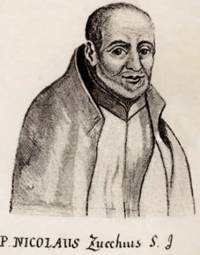Niccolò Zucchi facts for kids
Quick facts for kids
Niccolò Zucchi
|
|
|---|---|

Niccolò Zucchi
|
|
| Born | December 6, 1586 |
| Died | May 21, 1670 (aged 83) |
| Nationality | Italian |
| Known for | physics, astronomy, reflecting telescope |
| Parent(s) | Pietro Zucchi and Francesca Zucchi (née Giandemaria) |
| Scientific career | |
| Fields | Astronomy |
| Institutions | Roman College |
Niccolò Zucchi (December 6, 1586 – May 21, 1670) was an Italian Jesuit priest, astronomer, and physicist. He made important observations of planets and explored new ideas for telescopes.
Zucchi may have been the first person to see the belts on the planet Jupiter in 1630. He also reported seeing spots on Mars in 1640. His book, Optica philosophia, described an early idea for a reflecting telescope.
Contents
Niccolò Zucchi's Life Story
Niccolò Zucchi was born in Parma, Italy, in 1586. He was the fourth of eight children in a noble family. Many of his siblings also joined religious orders. Three of his sisters became nuns. Three of his brothers became Jesuits, like Niccolò.
Becoming a Jesuit
Niccolò studied rhetoric (the art of speaking and writing well) in Piacenza. He then studied philosophy and theology in Parma. At the age of sixteen, he joined the Jesuit order in Padua in 1602. He remained a Jesuit for the rest of his life.
Zucchi taught different subjects as a professor at the Collegio Romano in Rome. He taught mathematics, rhetoric, and theology. Later, he became the head (rector) of a new Jesuit college in Ravenna. He also served as a special preacher for the Pope for about seven years.
He received support from powerful people, like Duke Ranuccio II Farnese. Zucchi dedicated one of his books, Nova de machinis philosophia, to the Duke. He also dedicated his 1652 book, Optica philosophia, to Archduke Leopold of Austria. Niccolò Zucchi passed away in Rome in 1670.
Zucchi's Scientific Discoveries
Niccolò Zucchi wrote several books about science. These included two works on "the philosophy of machines," which explored how machines work. His most famous book was Optica philosophia, published in 1652. He also wrote about magnetism and barometers. Zucchi showed that phosphors create their own light, instead of just storing it.
An Astronomer's View
In 1623, Zucchi was part of a group sent by the Pope to visit Emperor Ferdinand II. There, he met Johannes Kepler, a famous German mathematician and astronomer. Kepler encouraged Zucchi's interest in astronomy.
Zucchi and Kepler continued to write letters to each other. At one point, Zucchi even gave Kepler a telescope he had designed. Kepler mentioned this gift in his own book, "The Dream."
Zucchi, along with another Jesuit, Daniello Bartoli, might have been the first to see the belts on Jupiter. This observation happened on May 17, 1630. Zucchi also reported seeing spots on Mars in 1640. A crater on the Moon, called Zucchius, is named in his honor.
Zucchi's Books
- Nova de machinis philosophia, Rome, 1649.
- Optica philosophia experimentis et ratione a fundamentis constituta (1652–56)
The Reflecting Telescope Idea
One of Niccolò Zucchi's most interesting ideas was about the reflecting telescope. In his 1652 book, Optica philosophia, he wrote about an experiment he did in 1616. This experiment explored the idea of using a curved mirror instead of lenses to make a telescope.
Zucchi's Experiment
Zucchi used a concave lens as an eyepiece. He tried to look through it at an image made by a bronze parabolic mirror. He found this mirror in a collection of interesting objects. He hoped it would work like a telescope.
However, Zucchi did not get a clear image. This might have been because the mirror was not perfectly shaped. Also, the way he tilted the mirror, or even his own head, might have blocked some of the light. Because of these problems, Zucchi gave up on the idea.
If Zucchi's experiment in 1616 was the first time someone tried to use a curved mirror for a telescope, it would be very important. It would mean his idea came before similar discussions by famous scientists like Galileo Galilei in the 1620s.
Claims and Debates
Some people have claimed that Niccolò Zucchi successfully used his early reflecting telescope. For example, a French writer named Bernard le Bovier de Fontenelle wrote in 1700 that Zucchi used it to observe "celestial and terrestrial objects." There are also modern claims that Zucchi used a reflecting telescope to see Jupiter's belts and Mars's spots.
However, many historians and scientists disagree with these claims. They point out that a tilted mirror would have made the image unclear. Experts believe that Zucchi used a refracting telescope (which uses lenses) for his astronomical observations. He used telescopes made by other craftsmen for his work.
See also
- List of Jesuit scientists
- List of Roman Catholic scientist-clerics
- Zucchius (crater), lunar crater named after Niccolò Zucchi

